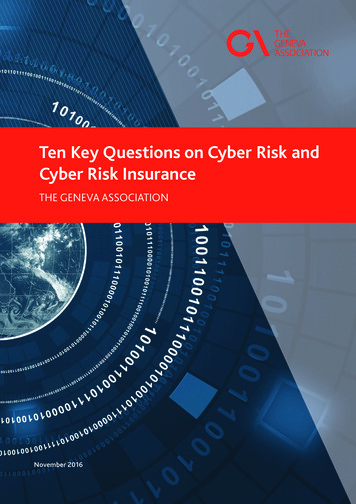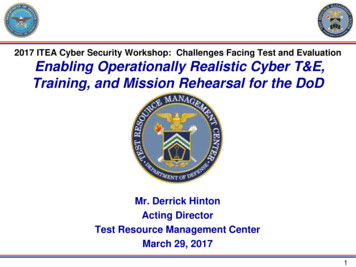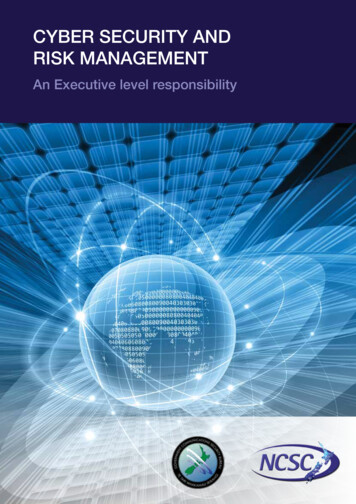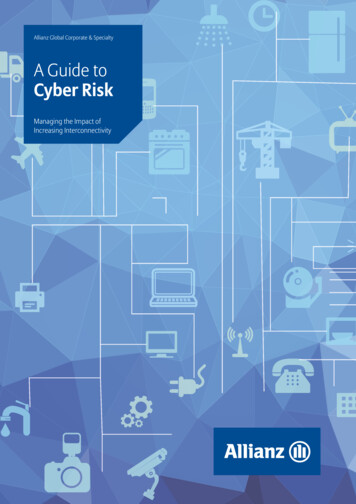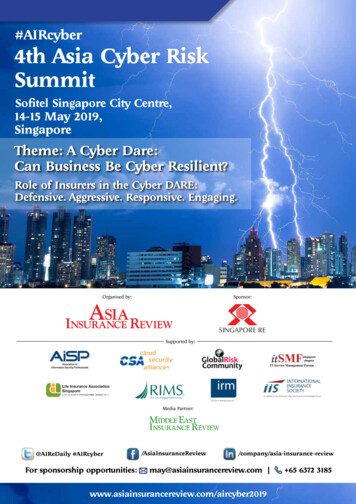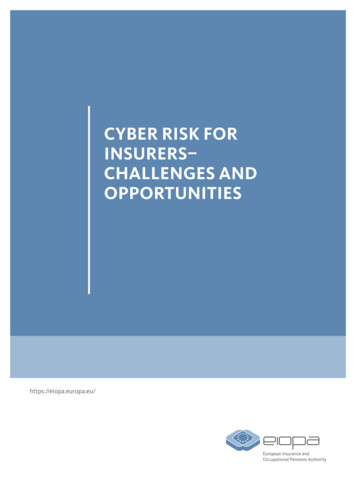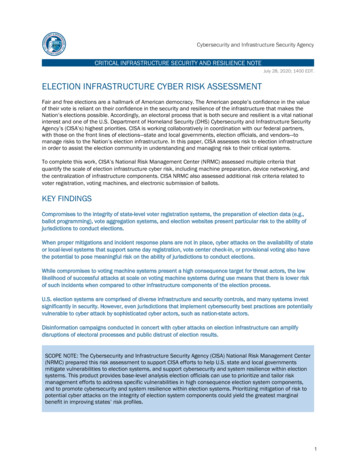
Transcription
CRITICAL INFRASTRUCTURE SECURITY AND RESILIENCE NOTEJuly 28, 2020; 1400 EDT.ELECTION INFRASTRUCTURE CYBER RISK ASSESSMENTFair and free elections are a hallmark of American democracy. The American people’s confidence in the valueof their vote is reliant on their confidence in the security and resilience of the infrastructure that makes theNation’s elections possible. Accordingly, an electoral process that is both secure and resilient is a vital nationalinterest and one of the U.S. Department of Homeland Security (DHS) Cybersecurity and Infrastructure SecurityAgency’s (CISA’s) highest priorities. CISA is working collaboratively in coordination with our federal partners,with those on the front lines of elections—state and local governments, election officials, and vendors—tomanage risks to the Nation’s election infrastructure. In this paper, CISA assesses risk to election infrastructurein order to assist the election community in understanding and managing risk to their critical systems.To complete this work, CISA’s National Risk Management Center (NRMC) assessed multiple criteria thatquantify the scale of election infrastructure cyber risk, including machine preparation, device networking, andthe centralization of infrastructure components. CISA NRMC also assessed additional risk criteria related tovoter registration, voting machines, and electronic submission of ballots.KEY FINDINGSCompromises to the integrity of state-level voter registration systems, the preparation of election data (e.g.,ballot programming), vote aggregation systems, and election websites present particular risk to the ability ofjurisdictions to conduct elections.When proper mitigations and incident response plans are not in place, cyber attacks on the availability of stateor local-level systems that support same day registration, vote center check-in, or provisional voting also havethe potential to pose meaningful risk on the ability of jurisdictions to conduct elections.While compromises to voting machine systems present a high consequence target for threat actors, the lowlikelihood of successful attacks at scale on voting machine systems during use means that there is lower riskof such incidents when compared to other infrastructure components of the election process.U.S. election systems are comprised of diverse infrastructure and security controls, and many systems investsignificantly in security. However, even jurisdictions that implement cybersecurity best practices are potentiallyvulnerable to cyber attack by sophisticated cyber actors, such as nation-state actors.Disinformation campaigns conducted in concert with cyber attacks on election infrastructure can amplifydisruptions of electoral processes and public distrust of election results.SCOPE NOTE: The Cybersecurity and Infrastructure Security Agency (CISA) National Risk Management Center(NRMC) prepared this risk assessment to support CISA efforts to help U.S. state and local governmentsmitigate vulnerabilities to election systems, and support cybersecurity and system resilience within electionsystems. This product provides base-level analysis election officials can use to prioritize and tailor riskmanagement efforts to address specific vulnerabilities in high consequence election system components,and to promote cybersecurity and system resilience within election systems. Prioritizing mitigation of risk topotential cyber attacks on the integrity of election system components could yield the greatest marginalbenefit in improving states’ risk profiles.1
CISA NRMC coordinated this analysis with the CISA Cybersecurity Division (CSD) and DHS’s Office ofIntelligence and Analysis (I&A) Cyber Mission Center (CYMC).ELECTION INFRASTRUCTURE SYSTEMS OVERVIEWElection infrastructure is comprised of a diverse set of systems, networks, and processes. The election systemin the United States is not one system, but a collection of many different systems. Each jurisdiction’s electioninfrastructure ecosystem is a collection of different components, some interconnected electronically andothers not, that must function together to conduct elections. Although they perform the same functions, systemprocesses and infrastructure vary from state-to-state and often differ even between counties, parishes, towns,or cities within a state or territory. 1Figure 1 provides a functional overview of a U.S. election ecosystem.FIGURE 1—ELECTION SYSTEM FUNCTIONAL ECOSYSTEMElection systems use diverse infrastructure and security controls. Even jurisdictions that deploy cybersecuritybest practices are potentially vulnerable to attacks from sophisticated cyber actors, such as advanced nationstate actors. Therefore, detection and recovery methods are equally significant as preventative measures.Cyber attacks on the integrity of state-level voter registration, pollbooks, and election websites, as well as onthe preparation of ballots, voting machines, and tabulation systems, have the potential for greatest functionalimpact to the ability of jurisdictions to conduct elections, based on fault tree analysis i of election systemcomponents through each phase of the election process. The following election infrastructure represents thesystems, networks, and processes most critical to the security, integrity, and resilience of U.S. elections: Voter registration databases are used to enter, store, and edit voter registration information, such asservers that host the database and online portals that provide access. Voter registration is an ongoingprocess to create new records, update existing records, and remove outdated records. Voterregistration databases receive data automatically and indirectly (i.e. through manual entry) from avariety of sources, including other government agencies (e.g., the Department of Motor Vehicles) andorganizations that aid in the registration process (e.g., voter registration campaigns). The databasescontain information on whether people are entitled to vote, where they can vote, and on what uniqueballot style they will vote, based upon voter geographical placement within multiple layers of politicaland taxing districts. Electronic and paper pollbooks contain information on registered voters at polling places, and can beused to register voters where permitted by law. Before use, pollbooks must be prepared bytransferring information from the voter registration database. Pollbooks are comprised of bothtechnology and processes to view, edit, and modify voter records. Pollbooks may be either networkedor non-networked. Networked pollbooks are electronic pollbooks with a connection to an externalFault tree analysis is a widely used method in system reliability, maintainability, and safety analysis. It is a deductive procedure used todetermine combinations of hardware and software failures and human errors that could cause undesired outcomes at the system level.iCYBERSECURITY AND INFRASTRUCTURE SECURITY AGENCY2
database, and may include a direct connection to the voter registration database or a separate server.Non-networked pollbooks are either paper pollbooks or static digital files on computers. Ballot preparation is the process of overlaying political geographies with the contests and candidatesspecific to each district, and then translating those layouts into unique combinations of ballot data.Ballot preparation data takes multiple forms such as ballot images (both paper and electronic), thedata files necessary to build ballot images, audio files for special use ballots, and specific files forexport to external systems such as websites or Uniformed and Overseas Citizens Absentee Voting Act(UOCAVA)-focused digital systems. Ballot preparation also generates the data necessary for tabulatingvotes within a voting machine, and aggregating tabulated votes within a jurisdiction or state. Thisprocess is usually completed in an election management system. Voting machine systems consist of the technology and processes used to cast and, in some cases,generate voter ballots of all types (paper-based systems, and electronic-based systems like ballotmarking devices and direct-recording electronic machines with or without a voter-verified paper audittrail). Voting machines encompass both technology and processes used by election officials to preparevoting machines for ballot tabulation, and in some cases presentation. Specifically, this includesloading the ballot files created during ballot preparation onto voting machines. Voting machines areheld in storage in the custody of election officials, but after delivery are placed at voting locations foruse during early voting and on Election Day. Voting machines are the most visible form of technologythat voters interact with during the voting process. Centralized vote tabulation and aggregation systems are used to tally votes shared by sub-jurisdictionssuch as counties, precincts, and in some cases individual machines or even individual ballots. Thesesystems collect and process data to determine the result of an election contest. Tabulationencompasses both technology and processes used to count votes and aggregate results. Votetabulation processes include hand counting, optical scans of paper ballots, and direct electronictabulation. Vote tabulation may occur at the precinct-level in addition to centralized tabulation. Official websites are used by election officials to communicate information to the public, including howto register to vote, where to vote (e.g., precinct look-up tools), and to convey election results (e.g.,election night reporting systems). Sometimes election websites are hosted on government-ownedinfrastructure, but are often hosted by commercial partners. Storage facilities, which may be located on public or private property, and may be used to storeelection and voting system infrastructure before Election Day. Polling places (including early voting locations) are locations where individuals cast their votes andmay be physically located on public or private property. Election offices are locations where election officials conduct official business, including sharedworkspaces such as public libraries, municipal buildings, private homes, and public areas forjurisdictions without a dedicated workspace.ELECTION INFRASTRUCTURE CYBER ATTACK CONSEQUENCESAnalysis determined that cyber attacks on each component of the election infrastructure ecosystem may havediffering consequences, based on type of cyber impact and the specific targeted election system component.This assessment used the Confidentiality-Integrity-Availability (CIA) Triad information security model ii to analyzethree types of cyber attacks: Confidentiality Attacks, the theft of information; Integrity Attacks, the changing of either the information within or the functionality of a system; and Availability Attacks, the disruption or denial of the use of the system.(U) For more information on the CIA triad, refer to: Center for Internet Security, “EI-ISAC Cybersecurity Spotlight – CIA Triad,” cybersecurity-spotlight-cia-triad/. Accessed July 28, 2020.iiCYBERSECURITY AND INFRASTRUCTURE SECURITY AGENCY3
Risks can also differ for the same component during preparation and during use (e.g., voting machines may bemore accessible to cyber attacks during preparation than on Election Day). Additionally, a successful cyberattack on a voting machine could also cascade onto a tabulation or aggregation system if malware istransferred after voting is complete.Table 1 provides a high-level overview of the potential consequence of a successful cyber attack by systemcomponent. This table does not directly address cyber attacks aimed at undermining public confidence inelections, though the three types of attacks could have a primary or secondary goal of undermining confidence.TABLE 1—POTENTIAL CONSEQUENCE OF AN ELECTION CYBER ATTACK BY CEINTEGRITYCONSEQUENCEAVAILABILITYCONSEQUENCEVoter RegistrationExpose Non-publicVoter RegistrationInformationChange Voter RegistrationInformationPrevent Access to VoterRegistration InformationPollbook PreparationExpose Non-publicVoter RegistrationInformationChange Voter RegistrationInformationPrevent Access to VoterRegistration InformationBallot PreparationExpose BallotInformationChange Ballot InformationDuring PreparationPrevent Ballot PreparationVoting MachinePreparationChange Voting MachineFunctionality to ExposeVoter ChoicesChange Voting MachineFunctionality(Presentation ofBallot/Recording ofChoices)Prevent Voting MachineFunctionalityTabulation PreparationChange TabulationMachine Functionalityto Expose ResultsChange TabulationMachine FunctionalityPrevent TabulationMachine FunctionalityPollbook UseExpose Non-publicVoter RegistrationInformationChange Voter RegistrationInformation (In Pollbook)Prevent Access to VoterRegistration InformationVoting Machine UseExpose Voter ChoicesChange Voting MachineFunctionalityPrevent Voting MachineFunctionalityTabulation (Precinct)Expose TabulationResults BeforeIntendedChange Results of VoteTabulationPrevent Vote TabulationTabulation (Central)Expose TabulationResults BeforeIntended (Aggregation)Change Results of VoteTabulation (Aggregation)Prevent Vote Tabulation(Aggregation)Aggregation (State)Expose AggregationResults BeforeIntendedChange Results of VoteAggregationPrevent Vote AggregationWebsiteExpose Information NotIntended for PublicDisclosureChange Reported ResultsPrevent Reporting ofResultsCYBERSECURITY AND INFRASTRUCTURE SECURITY AGENCY4
INTEGRITYCONSEQUENCEExpose Information NotIntended for PublicDisclosureChange Voter Registrationand Precinct Information(In Voter Lookup)AVAILABILITYCONSEQUENCEPrevent Voter Lookup ofRegistration and PrecinctInformationJOINT ELECTION INFRASTRUCTURE AND DISINFORMATION ATTACKSForeign state and non-state actors leverage information activities as part of broad campaigns to sow discord,manipulate public discourse, and discredit the electoral system to undermine pillars of democracy. In thecontext of elections, foreign entities aim to: Dissuade target audiences from participating in the electoral process through content that suggeststheir votes do not matter, that abstaining from voting is the most democratic action, or throughcontent that misleads voters about the process of voting. Impact candidate selection through, among other activities, pushing fabricated and favorable contentabout preferred candidates, and fabricated or disparaging content about disfavored candidates. Damage the public perception of a fair and free election by pushing false or misleading contentregarding election processes and results.These disinformation campaigns, conducted in concert with cyber attacks on election infrastructure, canamplify disruptions of electoral processes and public distrust of election results. Unauthorized network accessallows for surveillance and reconnaissance, and provides opportunities for destructive cyber attacks. Stolen orfalsified information can be strategically leaked to shape false narratives. Hijacking online personas and thedefacement or alteration of public-facing sites can be leveraged to influence public opinion. The targeting ofgovernment systems (even without compromise) can be used to form narratives leading to distrust of thegovernment as stewards of citizen information.ELECTION INFRASTRUCTURE RISK CRITERIABased on these consequences, the assessment applied multiple criteria that assess the scale of cyber riskassociated with election infrastructure. The potential scale of an election infrastructure cyber attack is basedon factors including whether the infrastructure is being prepared for use or is in use, whether infrastructuretechnology is networked, and the degree to which infrastructure components are centralized. Risk criteriaconsiderations are not mutually exclusive.CISA also assesses additional risk criteria related to voter registration, voting machines, and electronicsubmission of ballots.Attack Scale: System PreparationThe potential scale of a cyber attack on election infrastructure will be more widespread if a cyber attack occursduring the preparation or programming of election infrastructure versus during its immediate use. While anintegrity cyber attack on a single voting machine in a precinct would affect that machine or precinct, cyberattacks on a jurisdiction’s central preparation or programming of machines may affect the entire jurisdictionusing those machines. If preparation of machines is conducted at the state level, cyber attacks on thepreparation process have the potential to impact an entire state. This is true for a single election. However,malware inserted into a single machine during use could propagate to the tabulation and preparations system,CYBERSECURITY AND INFRASTRUCTURE SECURITY AGENCY5
and to all machines in future elections if jurisdictions do not follow best practices for using secure electionsoftware system builds.During system preparation, election jurisdictions rely on files from external sources, such as registrationdatabases, voting system vendors, ballot printers, or ballot programmers. Importing data from external sourcesraises risk, since sources may use internet connected systems that do not follow cybersecurity best practices.Additionally, an external source may present a cyber attack vector against a wide variety of electionjurisdictions if a single source services multiple jurisdictions or states.Attack Scale: System NetworkingThe scale of a cyber attack on election infrastructure has the potential to be more widespread if an attackcompromises networked infrastructure. For example, electronic pollbooks in some jurisdictions are networkedtogether across the jurisdiction to facilitate vote center operation, whereas electronic pollbooks in otherjurisdictions are non-networked. A cyber attack on an individual non-networked pollbook has less chance tospread if the machine remains isolated from a network. An integrity attack on a networked e-pollbook has thepotential to affect an entire jurisdiction, while an integrity attack on a local, non-networked pollbook can beisolated to that particular voting location.Because of that, we assess network connectivity for voting systems to be high risk. Creating and maintainingan airgap for critical systems, such as the vote casting or vote tabulation systems, is a best practice. iiiAttack Scale: CentralizationThe potential scale of a cyber attack will be more widespread if an attack targets a centralized process versusa localized process. Some jurisdictions tabulate votes at each polling location before aggregating results at acentral location, while others only tabulate votes at a central location. An integrity attack on central tabulationsystems or processes has the potential for a broader reach than an integrity attack on local tabulation process.Table 2 provides a brief summary of criteria used to assess cyber risk associated with the potential scale of anelection-related cyber attack, assessed by an election infrastructure component. We categorize the scale of anattack into one of three categories: Low: Affecting a subset of a jurisdiction Medium: Affecting an entire jurisdiction High: Affecting an entire state or multiple jurisdictionsFor a more detailed look at cyber risk by component, refer to “Table 3—Election Infrastructure RiskPrioritization Matrix” on page 10.iiiAn airgap is a physical separation between systems that requires data to be moved by some external, manual procedure.CYBERSECURITY AND INFRASTRUCTURE SECURITY AGENCY6
TABLE 2—POTENTIAL SCALE OF AN ELECTION CYBER ATTACK BY COMPONENTELECTIONCOMPONENTATTACK VECTORSCALEVoter RegistrationJurisdiction Registration DatabaseMediumVoter RegistrationState Registration DatabaseHeavyPollbookJurisdiction Pollbook PreparationMediumPollbookState Pollbook PreparationHeavyPollbookNon-Networked Pollbook UseLowPollbookJurisdiction Networked Pollbook UseMediumPollbookState Networked Pollbook UseHeavyBallot PreparationJurisdiction Ballot PreparationMediumBallot PreparationState Ballot PreparationHeavyVoting MachineJurisdiction Voting Machine PreparationMediumVoting MachineState Voting Machine PreparationHeavyVoting MachineVoting Machine UseLowTabulationTabulation PreparationMediumTabulationPrecinct Tabulation UseLowTabulationCentral Tabulation UseMediumTabulationState AggregationHeavyCYBERSECURITY AND INFRASTRUCTURE SECURITY AGENCY7
ELECTIONCOMPONENTATTACKER VECTORSCALEWebsiteJurisdiction WebsiteMediumWebsiteState WebsiteHeavyNumber of Registered VotersElectoral jurisdictions vary greatly in size, with some having as few as 100 voters to the largest encompassingseveral million voters. 2 Jurisdictions with more registered voters manage more risk than jurisdictions withsmaller voter populations. The number of registered voters represents the number of individuals in eachjurisdiction who could have personal information exposed during a confidentiality attack or experiencedisruptions at polling places as a result of cyber attacks, or election-related cascading impacts from physicalincidents.Voter Registration System ConfigurationStates manage their voter registration systems in three primary ways. 3 States with top-down voter registrationsystem host data on a single, central platform of hardware, which is maintained by the state with data andinformation supplied by local jurisdictions. Bottom-up systems feature data hosted on local hardware andperiodically compiled to form a statewide voter registration list. Hybrid systems are a combination of top-downand bottom-up characteristics. As of 2018, 39 states and territories have voter registration systems that aretop-down configurations. 4States with top-down voter registration systems present attackers with a single system that, if compromised,could disrupt the voting process at a broader scale than jurisdiction-level systems. Since top-down voterregistration systems maintain the entire voter registration database for a state, they present a single target forattack that could disrupt many more voters. A bottom-up or hybrid system would require the compromise of adiverse number of systems across a state to achieve similar results. However, cyber and physical security oftop-down systems is more likely to be stronger than bottom-up or hybrid systems, based on a review of overallstate and local cybersecurity resources and support.Online Voter RegistrationOnline voter registration allows residents to complete voter registration forms online. Forty states andterritories offer an online voter registration portal in which individuals can register on their own without havingto submit a paper form. 5Online voter registration systems provide an additional point of vulnerability to enable cyber actors to gainaccess to voter registration databases and conduct confidentiality, integrity, or availability attacks. 6 Hackers,including nation-state actors, have exploited voter databases in the past to gain illicit access to voterinformation. 7Measures such as same day registration iv and provisional ballots are likely to reduce impact of integrity attacksto voter registration systems by providing a fail-safe mechanism to allow eligible voters to correct tampered ordeleted data and vote using established processes. Help America Vote Act-required provisional ballotiv Same day registration is the procedure for individuals to register to vote and cast a ballot on the same day. According to the U.S. ElectionAssistance Commission Election Administration and Voting Survey, 26 states have some form of same day registration, as of 2018.CYBERSECURITY AND INFRASTRUCTURE SECURITY AGENCY8
processes v also provided a fail-safe measure of resilience. Even though same-day registration and provisionalballots can provide resiliency, both have the potential to cause disruptions at polling places due to longerprocessing times that can be required to administer provisional ballots (approximately 15 percent longer thanthat of normal ballot processes, depending upon the specific processes election officials deploy). Additionally,many election officials believe the best implementation of same-day registration utilizes network connectedtechnology, such as electronic pollbooks, introducing system networking risks, as discussed above.Voting Machines Without Voter Verified Auditable Paper RecordDirect-recording electronic voting machines capture voting data directly into electronic memory. 8 Many directrecording electronic voting machines come equipped with a voter-verified paper audit trail feature thatprovides a printout, verifiable by voters, to ensure their votes are correctly captured. Since 2016, manyelection officials across the country replaced systems that do not have a voter verified auditable paper recordwith voting systems that do. Based on research, CISA estimates that greater than 90 percent of cast ballots in2020 will have a corresponding auditable record.We assess voting systems without a voter verified auditable paper record as presenting additional risk, basedon analysis of the difficulty of identifying electronic manipulation to ensure election integrity in the event of acyber attack. The existence of a voter verified auditable paper record is the first step in building resiliency, as itcan provide the ability for election officials to verify that the outcomes of the election are correct regardless ofwhether an undetected error or fault in the voting system occurs. However, to provide voters high assurancethat errors will be detected, election officials must also conduct regular audits of their elections.Logic and accuracy testing measures such as parallel monitoring vi and hash checks vii to ensure softwareintegrity against certified software builds are likely to improve the detection and recovery capability of electionofficials with regard to their voting systems; especially those without a record that cannot be otherwise audited,though neither measure can replace the use of paper backups to identify irregularities and reduce risk.Uniformed and Overseas Citizens Absentee Voting Act Electronic BallotsCertain groups of voters, particularly military and overseas voters, face challenges voting both in-person orthrough the mail. All jurisdictions are required to offer electronic ballot delivery, per federal law. Many state andlocal election officials additionally make use of email, fax, and web portals to aid in ballot return for thesegroups. 9,10 Thirty-one states viii and the District of Columbia (D.C.) allow voters covered by the Uniformed andOverseas Citizens Absentee Voting Act to submit their ballots by at least one electronic means, such as internetportal, email, or fax. 11 Five states (Arizona, Colorado, Missouri, North Dakota, and West Virginia) allowUniformed and Overseas Citizens Absentee Voting Act voters to return ballots using a web-based portal orapplication. Additionally, several counties within Utah, Colorado, and Oregon conducted a pilot using a mobilevoting application and are determining its use moving forward. 12 West Virginia used a similar application inprevious elections. Nineteen states ix and D.C. allow some voters to return ballots via email or fax, while sevenstates x allow some voters to return ballots via only fax.Provisional ballot processes, or provisional voting, maintains the individual’s intent to vote until election officials determine the eligibilitystatus of the individual to cast a ballot in the election. All states except for Minnesota, New Hampshire, and North Dakota issue provisionalballots to individuals on election day, per Section 302 of the Help America Vote Act.viParallel monitoring is the process of testing a set of randomly selected voting machines to be tested in election mode during the votingperiod. The intent is to try to “trick” the system into thinking that it is in a voting location and being used live in the election. Parallel testingcould then detect if malicious software had been deployed to only take effect in a specific mode (i.e. Election Mode) or during a specifiedtime (i.e. on Election Day).viiHash checks are useful to verify data integrity and are conducted by comparing the hash value of received data to the hash value of dataas it was sent to detect whether data was altered.viii The 31 states are: Alaska, Arizona, California, Colorado, Delaware, Florida, Hawaii, Idaho, Indiana, Iowa, Kansas, Louisiana, Maine,Massachusetts, Mississippi, Missouri, Montana, Nebraska, Nevada, New Jersey, New Mexico, North Carolina, North Dakota, Oklahoma,Oregon, Rhode Island, South Carolina, Texas, Utah, Washington, and West Virginia.ix The 19 states are: Delaware, Hawaii, Idaho, Indiana, Iowa, Kansas, Maine, Massachusetts, Mississippi, Montana, Nebraska, Nevada,New Jersey, New Mexico, North Carolina, Oregon, South Carolina, Utah, and Washington.x The seven states are: Alaska, California, Florida, Louisiana, Oklahoma, Rhode Island and Texas.vCYBERSECURITY AND INFRASTRUCTURE SECURITY AGENCY9
We assess electronic ballot return as presenting additional risk, whether through email, fax, web portal, ormobile application, based on the difficulty of securing the electronic transmission of data. Ballots submittedthrough electronic means are subject to increased potential to disruption, manipulation, or exposure.Risks to electronic ballot return are similar to mail-in ballots, but with the potential to impact a higher numberof ballots. For example, a man-in-the-middle attack on a physical mail-in ballot requires physical access, andattack scale is limited through proper chain of custody procedures. In contrast, a malicious cyber actor canconduct a man-in-the-middle attack on electronic ballots at a higher scale from a wide range of globallocations.ELECTION INFRASTRUCTURE RISK PRIORITIZATION MATRIXCISA NRMC assesses differing relative aggregat
SCOPE NOTE: The Cybersecurity and Infrastructure Security Agency (CISA) National Risk Management Center (NRMC) prepared this risk assessment to support CISA efforts to help U.S. state and local governments mitigate vulnerabilities to election systems, and support cybersecurity and system resilience within election systems.

